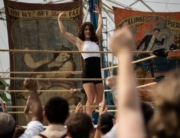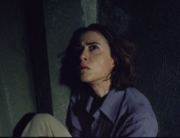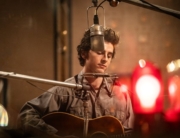Writer Beau Willimon had the luxury of 13 episodes a season to unwind the serpentine story lines of the political thriller House of Cards, allowing ample time for character development. Even the most ludicrous plot twist could come across as credible, especially during the show’s first two seasons. For that drama of pernicious political intrigue, he tossed a lot of balls in the air and kept them aloft. However, he now tackles the action-packed life of Mary, Queen of Scots, cramming her major successes and failures on the battlefield and bedroom into 124 minutes. Based on John Guy’s 600-page book Queen of Scots: The True Life of Mary Stuart, the screenplay tries to do too much. He and debut director Josie Rourke speed through the political and religious upheavals of the monarch’s time line, barely taking a breath, when any of the numerous narrative strands could have sufficed as a stand-alone film.
First story line: the 18-year-old Catholic queen (Saorise Ronan) arrives seasick back to Scotland in 1561 after her husband, France’s young Francis II, has died. She struggles for power with her half-brother, James, Earl of Moray (James McArdle), and to win over the Scottish nobles and appease the rising Protestant church, spearheaded by John Knox (an unrecognizable David Tennant) spewing venom: “A woman with a crown is a pestilence.”
Then there is her private life, her political marriage to the English nobleman Henry Stuart, Lord of Darnley (Jack Lowden), and the murder of musician David Rizzio (Ismael Cruz Cordova). The actual lead up to the second of her three marriages is simplified and way off the historical record.
On top of all of this, the screenplay throws in her overtures to her Protestant cousin, Elizabeth I of England, and their affectionate though tenuous tête-à-tête correspondence. The underlying idea is that if it weren’t for the interfering male politicians, the two cousins would have been close allies, even though they are aligned on opposite sides of religion and have rival claims to the English throne—a hopeful outlook considering the times they were living in. The film also posits that the Tudor queen holds out hope that Mary will relinquish her claim to the English crown, or at least offer some sort of detente. (The filmmakers assume viewers know most of the back history regarding the Tudor dynasty.)
That said, Rourke and her production team succinctly contrast the two courts. Mary is stuck in her dark, crumbling (read: poor) Holyrood Palace, with its fading medieval tapestries. She stands out, and not only because of her youth and gender; she wears lithe, simply cut dresses of bold colors. Your eye is instinctively drawn toward her. On the other hand, the Elizabethan Court is bathed in light and elaborate details, from the rosettes decorating her palace to the thousands of pearls in Elizabeth’s armor-like gowns that must weigh more than 50 pounds. The contrast is also on-point in the direction of the opposing ladies-in-waiting. Mary’s court relaxes, laughs, and gossips. Down south in London, they are circumspect, scrambling to please their boss.
Perhaps every generation has its own take on the oft-told tragic tale of the Scottish queen. Although the production of this film began before the #MeToo movement hit its stride in 2017, gender politics is definitely on the forefront confronting Mary, with more than a dose of contemporary sensibilities. Here Mary accepts an openly gay Rizzio into her court, “You have not betrayed your nature.” (How do we know he’s gay? Well, the first code signal occurs when Rizzio appears in drag as though he is one of the queen’s ladies-in-waiting.)
This film also makes many of the same assumptions as the 1971 version of the Scottish queen, starring Vanessa Redgrave, including imagining a gay fling involving the same two historical figures. That movie also crams 30 years of history into its running time, which raises a question. Why make another biopic covering the same people and events? Its raison d’être is mainly as a showcase for Ronan and Robbie. Both rise about the limitations of the script, but they most likely won’t challenge memories of any of their counterparts: Helen Mirren, Cate Blanchett, and Redgrave, to name a few.
Although this is a drive-by through history, the filmmakers stop and give the audience what they have been waiting for. Following in the footsteps of Schiller, playwright Maxwell Anderson, and composer Gaetano Donizetti, they rearrange history and have the two women meet, which famously they did not. But the showdown ends on a whimper; Mary holds the power by refusing from the get-go to acknowledge Elizabeth as a legitimate ruler, and she won’t back down, which gives little wiggle for the two rulers to flatter, manipulate, condescend, or appease. The confrontation doesn’t quite get as vicious or build up as much heat as other iterations; disappointingly, Mary refrains from calling Elizabeth a bastard.
The real departure here is in the portrayal of Elizabeth, who is portrayed as more vulnerable and wavering, in contrast to the formidable, steely Virgin Queen so often depicted. Robbie goes full Bette Davis, decked out in ornate bright red wigs and plastered in white face powder covering pox-marked scars—during Elizabeth’s illness, puss drips from the scabs.
Willimon has given her a more complex, unpredictable, and wide-ranging part. Whereas Mary never lets men see her cry, Rourke allows Robbie more opportunities to let her guard down, and Robbie takes full advantage of it. Although Mary may win the hearts and minds of filmgoers for her determination, Elizabeth conquers the onscreen battle.

















Leave A Comment